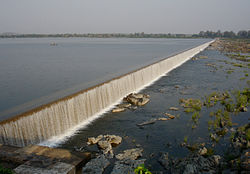This article needs additional citations for verification .(September 2023) |
| Darna river | |
|---|---|
 | |
| Location | |
| Country | India |
| State | Maharashtra |
| District | Nashik |
| City | Nashik |
| Physical characteristics | |
| Source | Kulang hill |
| • location | Sahyadris, Nashik, North Maharashtra, Maharashtra, India |
| • coordinates | 19°58′27″N73°56′12″E / 19.97417°N 73.93667°E |
| Mouth | Godavari River |
• location | Darnasangvi, Nashik, Khandesh, Maharashtra |
• coordinates | 19°10′46″N73°02′24″E / 19.17944°N 73.04000°E |
• elevation | 550 m (1,800 ft) |
| Length | 80 km (50 mi) |
| Basin features | |
| Tributaries | |
| • left | Vaki River, Aaundha River, Waldevi River |
| • right | Kadva river |
Darna is a minor right-bank tributary of the Godavari in the Nashik District, Maharashtra, India. Rising north of the Kalsubai range, it drains Igatpuri, Nashik and Niphad Talukas of Nashik District. The conjunction with Godavari is situated at Darnasangvi.



